FARMALL® 55C
FARMALL® 65C
FARMALL® 75C

Tractor

FARMALL® 55C
FARMALL® 65C
FARMALL® 75C

Tractor

Part number 84419878A

English
October 2011
This manual is divided into sections identified by two -figure numbers and each section has independent page numbering.
-- The different sections can easily be found by consulting the table of contents on the following pages.
-- The document number of the manual and the edition/update dates are given at the bottom of each page.
The pages of future updates will be identified by the same print number followed by an additional digit: standard manual first edition 84419878A - 1st update 84419878A1 - 2nd update 84419878A2 - etc. The pages of the update can replace or supplement the pages of the standard manual; the necessary information for the procedure to add or replace the pages is given on the title page of the update. The publication will be completed with an appropriate index.
If it is necessary to issue a new updated manual (2nd edition) it will have document number 84419878B, this indicates that the manual is composed of the standard version 84419878A completed with all the updates: 1st update 84419878A1 - 2nd update 84419878A2 - etc.
The information contained in this manual was current on the date printed on each section. As CASE IH constantly improves its product range, some information may be out of date subsequent to modifications implemented for technical or commercial reasons, or to meet legal requirements in different countries. In the event of conflicting information, consult the CASE IH Sales and Service Departments.
All maintenance and repair work described in this manual must be performed exclusively by CASE IH service technicians, in strict accordance with the instructions given and using any specific tools necessary.
Anyone performing the operations described herein without strictly following the instructions is personally responsible for any eventual injury or damage to property.
The Manufacturer and all organisations belonging to the Manufacturer’s distribution network, including but not restricted to national, regional or local distributors, will accept no responsibility for personal injury or damage to property caused by abnormal function of parts and/or components not approved by the Manufacturer, including those used for maintenance and/or repair of the product manufactured or marketed by the Manufacturer.
In any case, the product manufactured or marketed by the Manufacturer is covered by no guarantee of any kind against personal injury or damage to property caused by abnormal function of parts and/or components not approved by the Manufacturer.
No part of the text or illustrations may be copied
All maintenance and repair work described in this manual must be performed exclusively by CASE IH service technicians, in strict accordance with the instructions given and using any specific tools necessary. Anyone performing the operations described herein without strictly following the instructions is personally responsible for any eventual injury or damage to property.
Before carrying out any kind of service operation disconnect and isolate the battery negative lead, unless otherwise requested for specific operations (e.g.: operations requiring the engine to be running), after which it is necessary to disconnect the above -mentioned lead to complete the work.
For each adjustment operation, select adjusting shims and measure individually using a micrometer, then add up the recorded values. Do not rely on measuring the entire shimming set, which may be incorrect, or the rated value indicated for each shim.
For correct rotating shaft seal installation, proceed as follows:
- before assembly, allow the seal to soak in the oil it will be sealing for at least thirty minutes;
- thoroughly clean the shaft and check that the working surface on the shaft is not damaged;
- position the sealing lip facing the fluid; with hydrodynamic lips, take into consideration the shaft rotation direction and position the grooves so that they will deviate the fluid towards the inner side of the seal;
- smear the sealing lip with a thin layer of lubricant (use oil rather than grease) and fill the gap between the sealing lip and the dust lip on double lip seals with grease;
- insert the seal in its seat and press down using a flat punch, do not tap the seal with a hammer or mallet;
- whilst inserting the seal, check that the it is perpendicular tothe seat; once settled, makesurethat it makes contact with the thrust element, if required;
- to prevent damaging the seal lip on the shaft, position a protective guard during installation operations.
Lubricate the O-RING seals before inserting them in the seats, this will prevent them from overturning and twisting, which would jeopardise sealing efficiency.
Apply one of the following sealing compounds on the mating surfaces marked with an X: LOCTITE 518 or LOCTITE 5205 or SUPERBOND 559 or BETALOK A272M.
Before applying the sealing compound, prepare the surfaces as follows:
- remove any incrustations using a wire brush;
- thoroughly degreasethesurfacesusingoneofthefollowingcleaningagent:trichlorethylene, petrolorawater and soda solution.
When installing bearings it is advised to:
- heat the bearings to 80 ÷ 90 0C before fitting on the shafts;
- allow the bearings to cool before installing them from the outside.
When fitting split socket elastic pins, ensure that the pin notch is positioned in the direction of the force required to stress the pin.
Spiral spring pins do not require special positioning
Use genuine parts only.
Only genuine spare parts guarantee the same quality, duration and safety as they are the same parts that are assembled during production.
Only genuine parts can offer this guarantee.
When ordering spare parts, always provide the following information:
- tractor model (commercial name) and frame number;
- engine type and number;
- part number of the ordered part, which can be found on the “Spare Parts Catalogue”, which is the base for order processing.
The tools that CASE IH offer and illustrate in this manual are:
- specifically researched and designed for use with CASE IH vehicles;
- necessary to make a reliable repair;
- accurately built and strictly tested to offer efficient and long-lasting working means. By using these tools, repair personnel will benefit from:
- operating in optimal technical conditions;
- obtaining the best results;
- save time and effort;
- working in safe conditions.
Wear limit values indicated for certain parts are recommended, but not binding. The terms “front”, “rear”, “right -hand” and “left -hand” (when referred to different parts) are intended as seen from the driving position with the tractor in the normal direction of movement.
Externalpowersupplycablesshouldonlybeconnectedtotherespective positive andnegativecableterminals, using efficient clamps that guarantee adequate and secure contact.
Disconnect all services (lights, windshield wipers, etc.) before starting the vehicle. If the tractor electrical system requires checking, carry out operations with the power supply connected. Once checking is completed, disconnect allservices andswitch off the power supply beforedisconnectingthecables.
This warning symbol points out important messages concerning your safety.
Carefully read the following safety regulations and observe advised precautions in order to avoid potential hazards and safeguard your health and safety.
In this manual the symbol is accompanied by the following key -words:
WARNING - Warnings concerning unsuitable repair operations that may jeopardise the safety of Repair personnel.
DANGER - Specific warnings concerning potential hazards for operator safety or for other persons directly or indirectly involved.
Most accidents or injuries that occur in workshops are the result of non -observance of simple and fundamental safety regulations. For this reason, IN MOST CASES THESE ACCIDENTS CAN BE AVOIDED by foreseeing possible causes and consequently acting with the necessary caution and care.
Accidents may occur with all types of vehicle, regardless of how well it was designed and built. Acareful and judicious service technician is the best guarantee against accidents.
Precise observance of the most basic safety rule is normally sufficient to avoid many serious accidents. DANGER. Never carry out any cleaning, lubrication or maintenance operations when the engine is running.
- Carefully follow specified repair and maintenance procedures.
- Do not wear rings, wristwatches, jewels, unbuttoned or flapping clothing such as ties, torn clothes, scarves, open jackets or shirts with open zips which could get caught on moving parts. Use approved safety clothing such as anti -slipping footwear, gloves, safety goggles, helmets, etc.
- Do not carry out repair operations with someone sitting in the driver’s seat, unless the person is a trained technician who is assisting with the operation in question.
- Do not operate the vehicle or use any of the implements from different positions, other than the driver’s seat.
- Do not carry out operations on the vehicle with the engine running, unless specifically indicated.
- Stop the engine and ensure that all pressure is relieved from hydraulic circuits before removing caps, covers, valves, etc.
- All repair and maintenance operations must be carried out using extreme care and attention.
- Service steps and platforms used in a workshop or in the field should be built in compliance with the safety rules in force.
- Disconnect the batteries and label all controls to indicate that the vehicle is being serviced. Block the machine and all equipment which should be raised.
- Do not check or fill fuel tanks, accumulator batteries, nor use starting liquid when smoking or near naked flames, as these fluids are inflammable.
- Brakes are inoperative when manually released for repair or maintenance purposes. Use blocks or similar devices to control the machine in these conditions.
- The fuel nozzle should always be in contact with thefilling aperture: Maintain this contact untilthe fuel stops flowing into the tank to avoid possible sparks due to static electricity buildup.
- Only use specified towing points for towing the vehicle. Connect parts carefully. Make sure that all pins and/or locks are secured in position before applying traction. Never remain near the towing bars, cables or chains that are operating under load.
- Transport vehicles that cannot be driven using a trailer or a low -loading platform trolley, if available.
- When loading or unloading the vehicle from the trailer (or other means of transport), select a flat area capable of sustaining the trailer or truck wheels. Firmly secure the vehicle to the truck or trailer and lock the wheels in the position used by the carrier.
- Electric heaters, battery -chargers and similar equipment must only be powered by auxiliary power supplies with efficient ground insulation to avoid electrical shock hazards.
- Always use suitable hoisting or lifting devices when raising or moving heavy parts.
- Take extra care if bystanders are present.
- Never pour petrol or diesel oil into open, wide or low containers.
- Never use gasoline, diesel oil or other inflammable liquids as cleaning agents. Use non -inflammable, non -toxic commercially available solvents.
- Wear safety goggles with side guards when cleaning parts with compressed air.
- Limit the air pressure to a maximum of 2.1 bar, according to local regulations.
- Do not run the engine in confined spaces without suitable ventilation.
- Do not smoke, use naked flames, or cause sparks in the area when fuel filling or handling highly inflammable liquids.
- Never use naked flames for lighting when working on the machine or checking for leaks.
- All movements must be carried out carefully when working under, on or near the vehicle. Wear suitable safety clothing, i.e., hard hat, safety goggles and special shoes.
- When carrying out checks with the engine running,requesttheassistanceofanoperatorin
the driver’s seat. The operator must maintain visual contact with the service technician at all times.
- If operating outside the workshop, position the vehicle on a flat surface and lock in position. If working on a slope, lock the vehicle in position. Movetoaflatarea assoon asissafelypossible.
- Damaged or bent chains or cables are unreliable. Do not use them for lifting or towing. Always use suitable protective gloves when handling chains or cables.
- Chains should always be safely secured. Make sure that the hitch -up point is capable of sustaining the load in question. Keep the area near the hitch -up point, chains or cables free of all bystanders.
- Maintenance and repair operations must be carried out in a CLEAN and DRY area. Eliminate any water or oil spillage immediately.
- Do not create piles of oil or grease -soaked rags as they represent a serious fire hazard. Always place them into a metal container. Before starting the tractor or its attachments, check, adjust and block the operator’s seat. Also check that there are no persons within the vehicle or implement range of action.
- Empty pockets of all objects that may fall unobserved into the vehicle parts.
- In the presence of protruding metal parts, use protective goggles or goggles with side guards, helmets, special footwear and gloves.
- When welding, use protective safety devices: tinted safety goggles, helmets, special overalls, gloves and footwear. All persons present in the area where welding is taking place must wear tinted goggles. NEVER LOOK DIRECTLY AT THE WELDING ARC WITHOUT SUITABLE EYE PROTECTION.
- Metal cables tend to fray with repeated use. Always use suitable protective devices (gloves, goggles, etc.) when handling cables.
- Handle all parts with great care. Do not put your hands or fingers between moving parts. Always wear suitable safety clothing - safety goggles, gloves and shoes.
- Never run the engine in confined spaces that are not equipped with adequate ventilation for exhaust gas extraction.
- Never placethehead, body, limbs, feet,hands or fingers near fans or rotating belts.
- Always loosen the radiator cap slowly before removing it to allow any remaining pressure in the system to be discharged. Filling up with coolant should only be carried out with the engine stopped or idling (if hot).
- Never fill up with fuel when the engine is running, especially if hot, in order to prevent the outbreak of fire as a result of fuel spillage.
- Never check or adjust fan belt tension when the engine is running. Never adjust the fuel injection pump when the vehicle is moving.
- Never lubricate the vehicle when the engine is running.
- If it is necessary to use auxiliary batteries, remember that both ends of the cables must be connected as follows: (+) with (+) and ( -) with ( -). Avoid short -circuiting the terminals. GAS RELEASED FROM BATTERIES IS HIGHLY INFLAMMABLE. During charging, leave the battery compartment uncovered to improve ventilation. Never check the battery charge using ”jumpers” (metal objects placed on the terminals). Avoid sparks or flames near the battery zone. Do no smoke to prevent explosion hazards.
- Before servicing operations, check for fuel or current leaks. Eliminate any eventual leaks before proceeding with work.
- Never charge batteries in confined spaces. Make sure that there is adequate ventilation inorder to prevent accidentalexplosion hazards as a result of the accumulation of gases released during charging operations.
- Always disconnect the batteries before performing any kind of servicing on the electrical system.
- A liquid leaking from a tiny hole may be almost invisible but, at the same time, be powerful
enough to penetrate the skin. Therefore, use a piece of cardboard or wood for this purpose. NEVERDOITWITHYOURHANDS:Ifanyliquid penetrates skin tissue, call for medical aid immediately. Failure to treat this condition with correct medical procedure may result in serious infection or dermatosis.
- In order to check the pressure in the system use suitable instruments.
- Make sure that the tyres are correctly inflated at the pressure specified by the manufacturer. Periodicallycheck possible damagestotherims and tyres.
- Stand away from (at the side of) the tyre when checking inflation pressure.
- Only check pressure when the vehicle is unloaded and the tyres are cold, to avoid incorrect readings as a result of over -pressure. Do not reuse parts of recovered wheels as improper welding, brazing or heating may weaken the wheel and make it fail.
- Never cut or weld a rim mounted with an inflated tyre.
- To remove the wheels, lock both the front and rear vehicle wheels. After having raised the vehicle, position supports underneath, according to regulations in force.
- Deflate the tyre before removing any object caught in the tyre tread.
- Never inflate tyres using inflammable gases, as this may result in explosions and injury to bystanders.
- Lift and handle all heavy parts using suitable hoisting equipment. Make sure that parts are sustained by appropriate hooks and slings. Use the hoisting eyebolts for lifting operations. Extra care should be taken if persons are present near the load to be lifted.
- Handle all parts with carefully. Do not put your hands or fingers between parts. Wear suitable safety clothing, i.e. safety goggles, gloves and footwear.
- Avoid twisting chains or metal cables. Always wear safety gloves when handling cables or chains.
NOTE: For the main data, tightening torques, tools, diagrams, lubrication and cooling diagrams, fault diagnosis, disassembly -assembly, checks and overhauling, see the Repairs Manual print no. 84242026A - Italian; print no. 84208945A - English; print no. 84242024A - French; print no. 84242029A - Spanish; print no. 84242025A - German; print no. 84242023A - Dutch; print no. 84242028A - Portuguese; print no. 84242020A - Danish.
Engine, technical type:
- mod. 55C - type F5AE9454J*A (BOSCH pump)
- mod. 65C - type F5AE9454L*A (BOSCH pump)
- mod. 75C - type F5AE9454K*A (BOSCH pump)
Cycle diesel, 4-stroke Fuel injection .......................................... Direct
Compression ratio 17.5 ± 0.5:1
Maximum Power Output: - mod. 55C - type F5AE9454J*A 41 kW (55 Hp)
- mod. 65C - type F5AE9454L*A 48 kW (65 Hp)
- mod. 75C - type F5AE9454K*A 55 kW (75 Hp)
Maximum power speed 2300 rpm
Maximum torque speed 1400 rpm
Torque Rise ........................................... 35 (%)
Number of main bearings 5
Sump pan structural, cast iron
Lubrication .......................................... forced, with lobe pump
Pump drive from crankshaft
Oil filtration via mesh filter on inlet and cartridge on delivery
Normal oil pressure with motor warmed-up at fast idling ..... 2.9 ÷ 3.9 bar
Cooling ........................................ coolant circulation
Radiator 4 lines of vertical pipes with copper fins
Fan, attached to the pulley intake, in plastic with 11 blades
Coolant pump centrifugal vane -type
Temperature control via thermostat valve
- initial opening 79 ± 2 °C
Timing Intake:
- start: before T.D.C.
- end: after B.D.C.
Exhaust:
- start: before B.D.C.
- end: after T.D.C.
Clearance between valves and rocker arms with engine cold:
- intake .............................................
- exhaust
Fuel system
Air filtering
Fuel pump
Fuel filtration
Cam operated .........................................
BOSCH Injection pump
All-speed governor, incorporated in pump:
BOSCH
Automatic advance regulator, incorporated in pump:
BOSCH
Turbocharger
overhead valves operated by tappets, rods and rocker arms via the camshaft located in the engine block; the camshaft is driven by the crankshaft using straight -tooth gears
via dry air filter with double cartridge, clogging warning light with centrifuge prefilter and automatic exhaust of dust with double diaphragm
via mesh filter in the fuel pump, a renewable cartridge filter on the delivery to the injection pump via engine timing
rotating distributor type centrifugal counterweights hydraulic
- type HOLSET
Injection pump .........................................
BOSCH pump:
- mod. 55C - type F5AE9454J*A
- mod. 65C - type F5AE9454L*A ....................
- mod. 75C - type F5AE9454K*A ....................
Direction of rotation
Injection order
rotating distributor with speed governor and advance variator incorporated
VE 4/12 F1150 -504246316
VE 4/12 F1150 -504246318
VE 4/12 F1150-504246318
clockwise
1
(for all models)
84419878A
Lift and handle all heavy parts using suitable lifting equipment.
Make sure that assemblies or parts are supported by means of suitable slings and hooks. Ensure that no-one is in the vicinity of the load to be lifted.
Use suitable tools to align the holes. NEVER USE FINGERS OR HANDS.
1. Carry out operation 90 150 10 - Cab assembly with platform (do only the removal - see sect. 90, chapter 1).
2. Extract the fixing pin and remove the ballast weights (1); unscrew the fixing screws and recover the ballast support (2).
3. Position a suitable container under the rear transmission, unscrew the plug (1) and drain off the oil from the transmission.
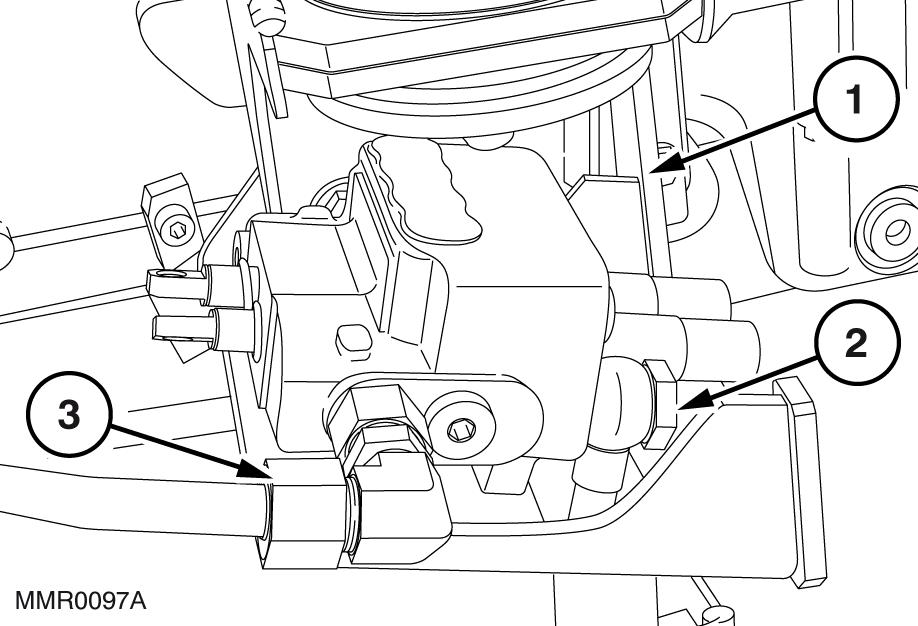
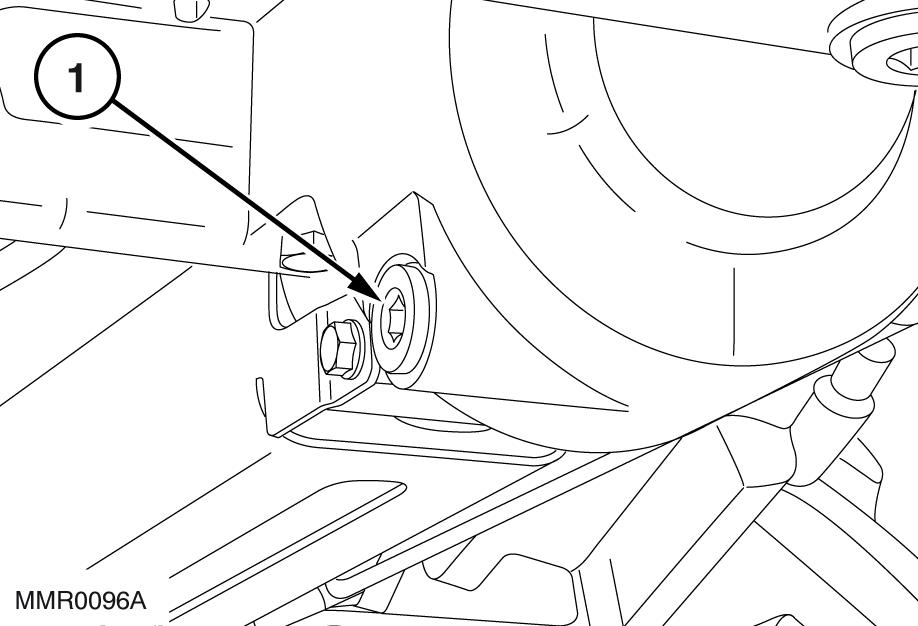
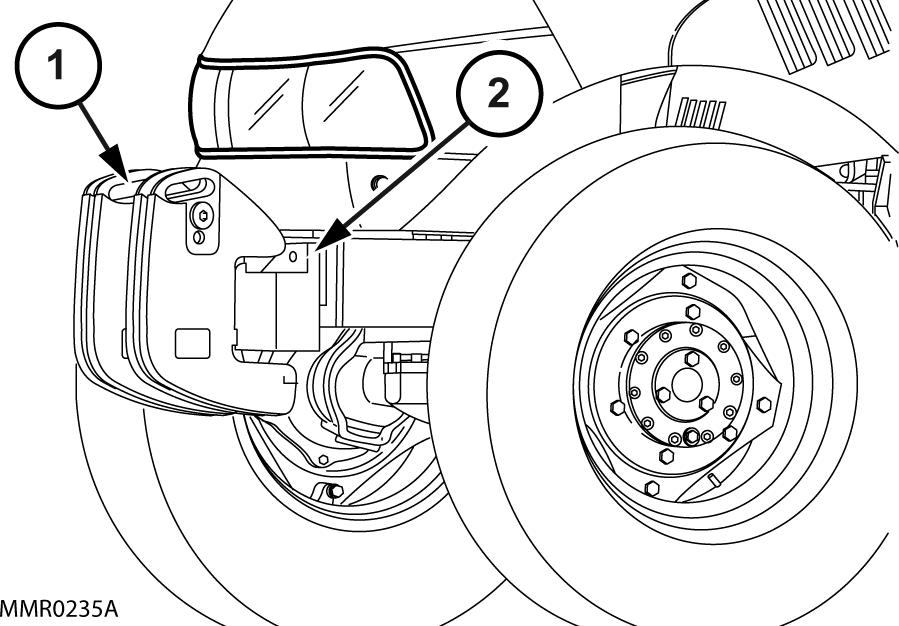
NOTE: Consider that the prescribed quantity is: 35 litres for mechanical transmissions or 40 litres for hydraulic transmissions.
4. Disconnect the pipes (2 and 3) from the central auxiliary control valves, unscrew the bracket fixing screws (1) supporting the control valves and remove the unit.
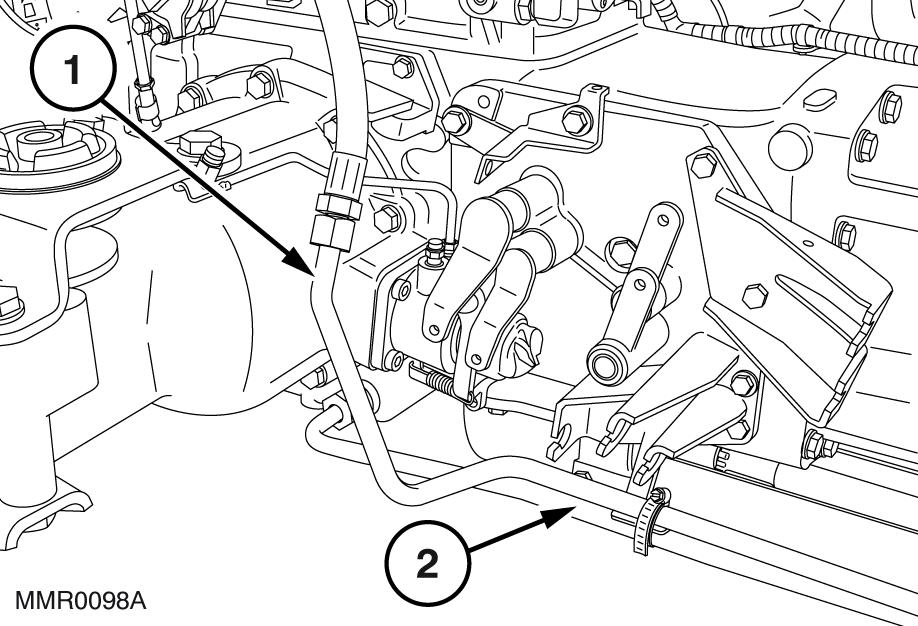
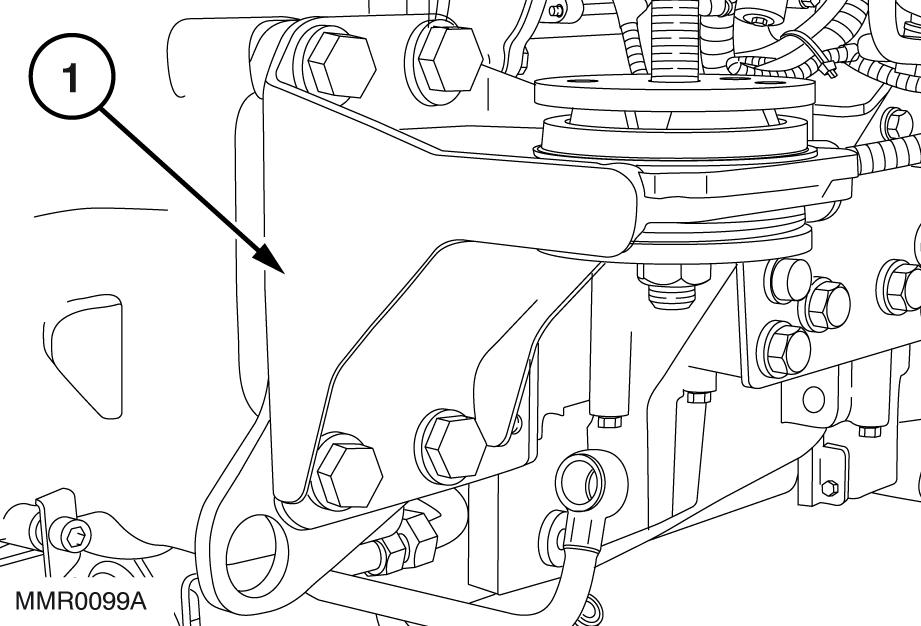
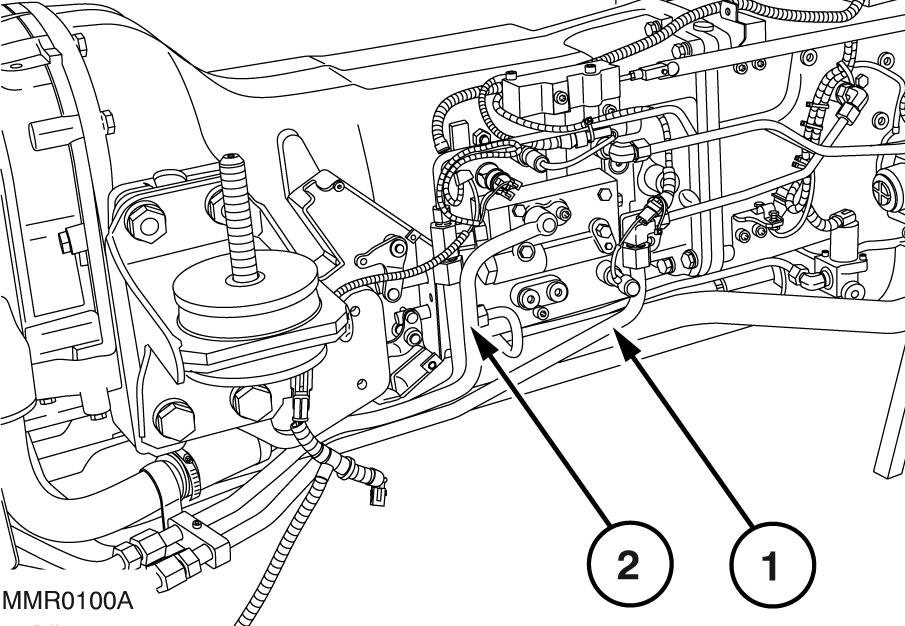


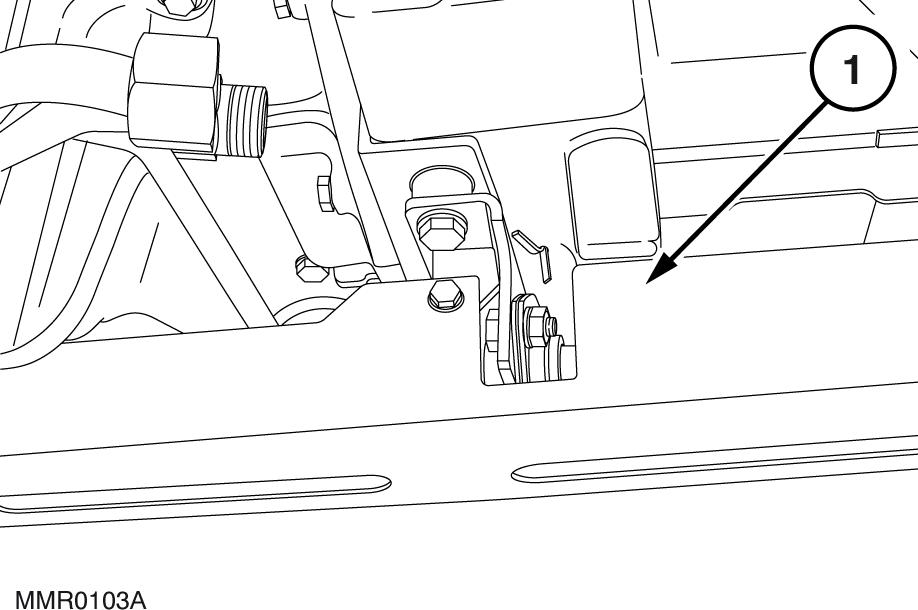
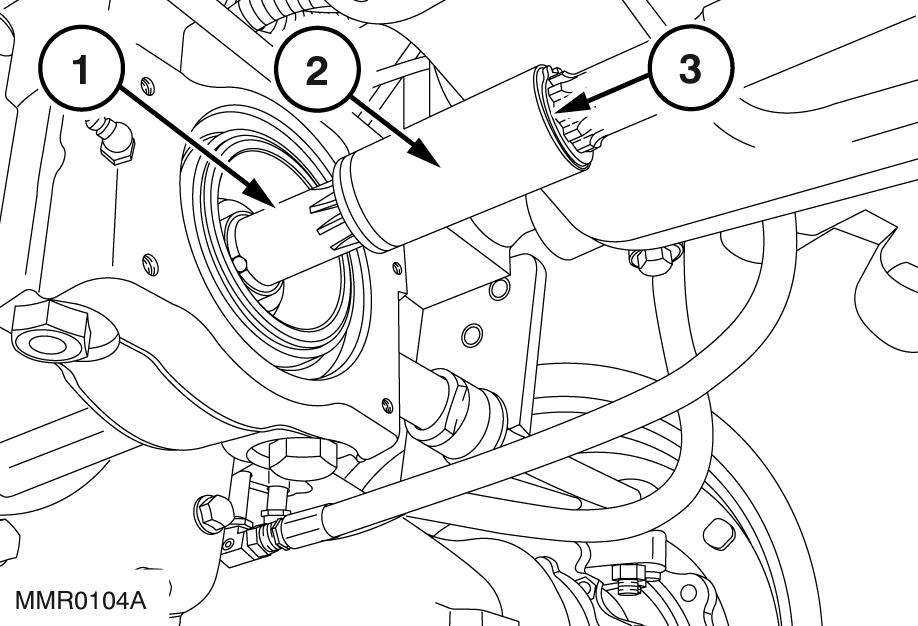
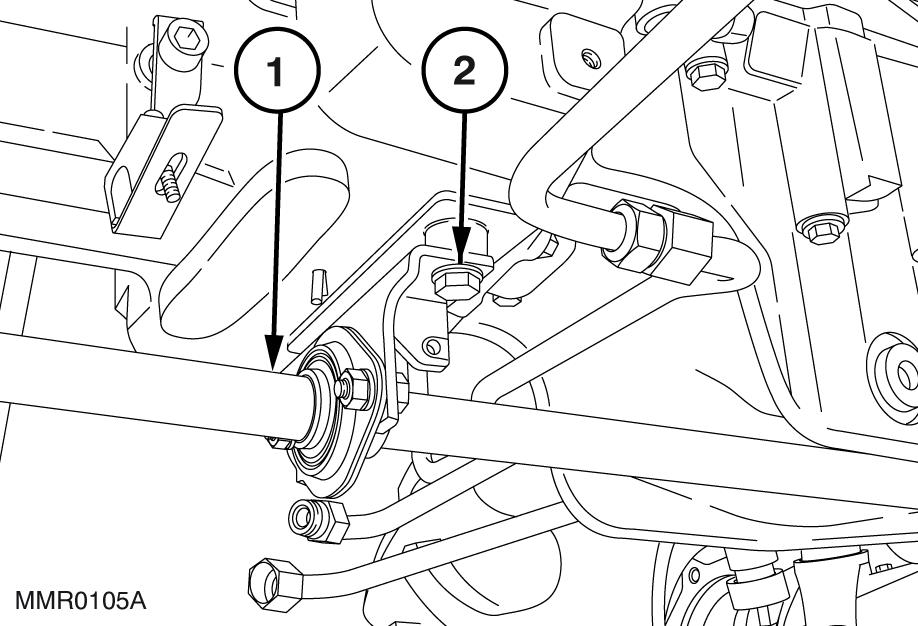
17. Disconnect the pipes: (1) connecting to the hydraulic pump, (2) connecting to the central auxiliary control valves and (4) hydraulic pump inlet.
18. Unscrew theretainingbolts andremove thefilter (3) and support.
19. Set a fixed stand under the clutch box, connect the rear of the engine to the hoist, unscrew the fixing screws (1) and detach the engine together with the front axle from the clutch box.
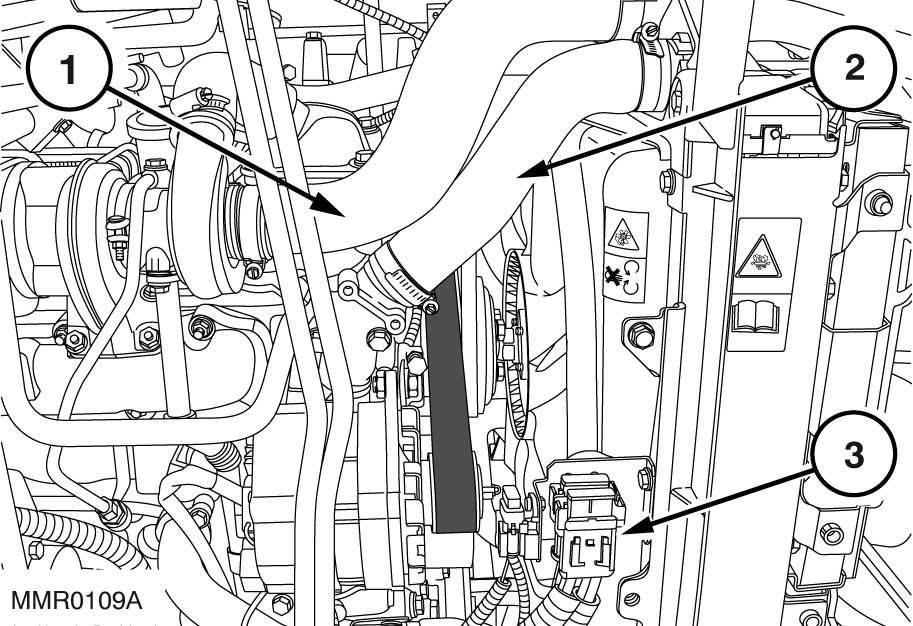
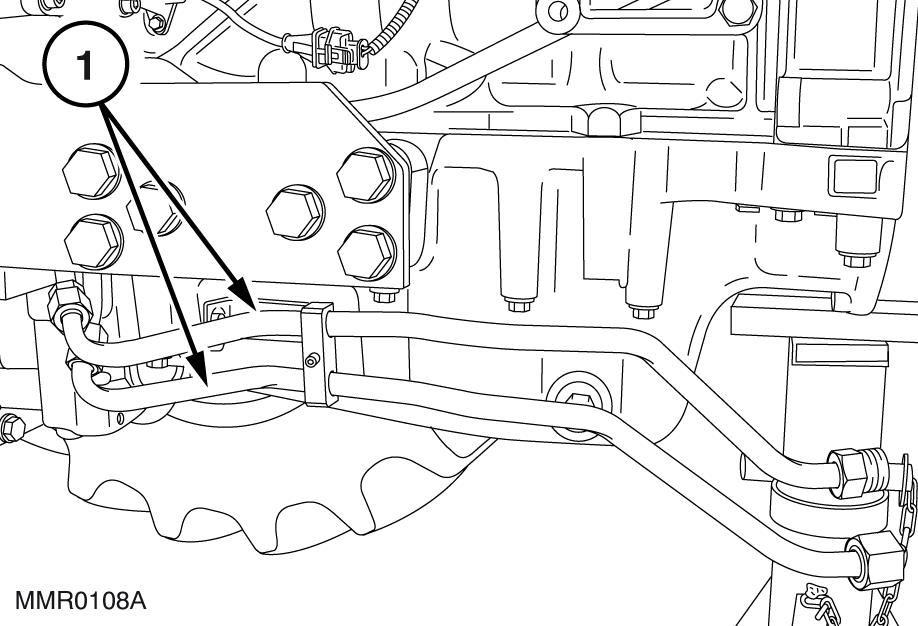

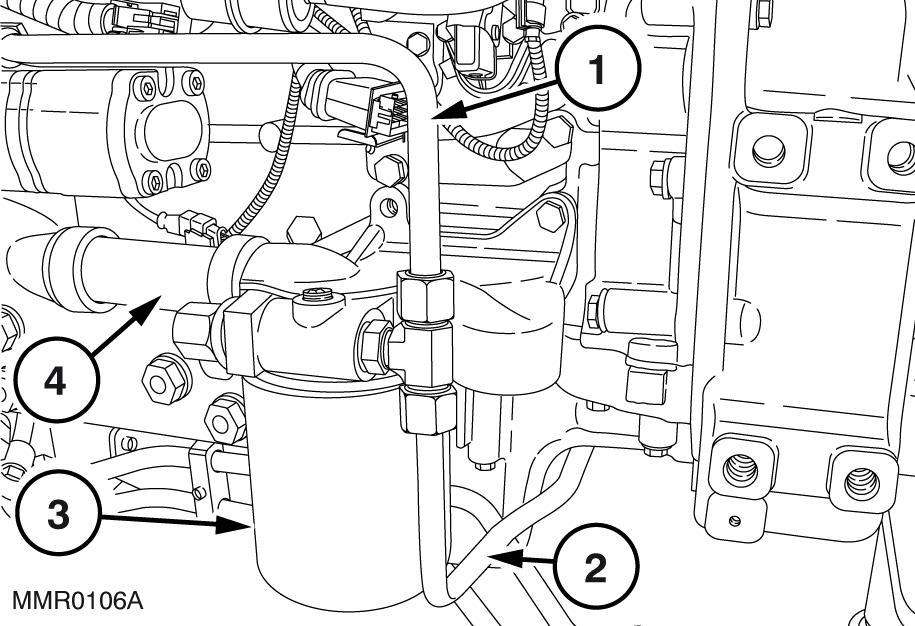
20. Disconnect the pipes (1) connecting to the transmission oil cooler.
21. Disconnect the radiator top sleeve (2).
22. Disconnect the sleeve (1) connecting the turbocharger to the air filter.
23. Unscrew the retaining bolts and detach the maxi -fuse support bracket (3).
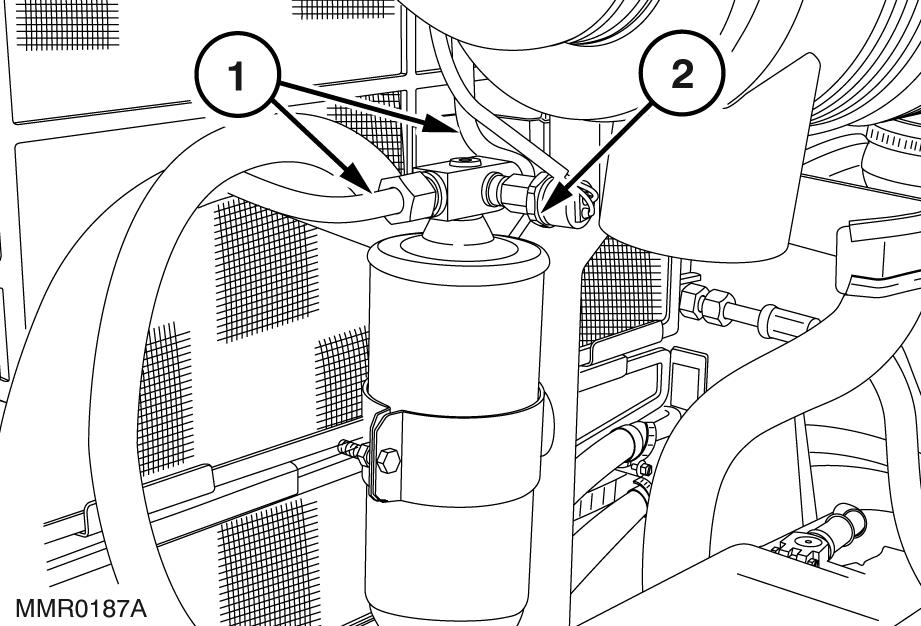
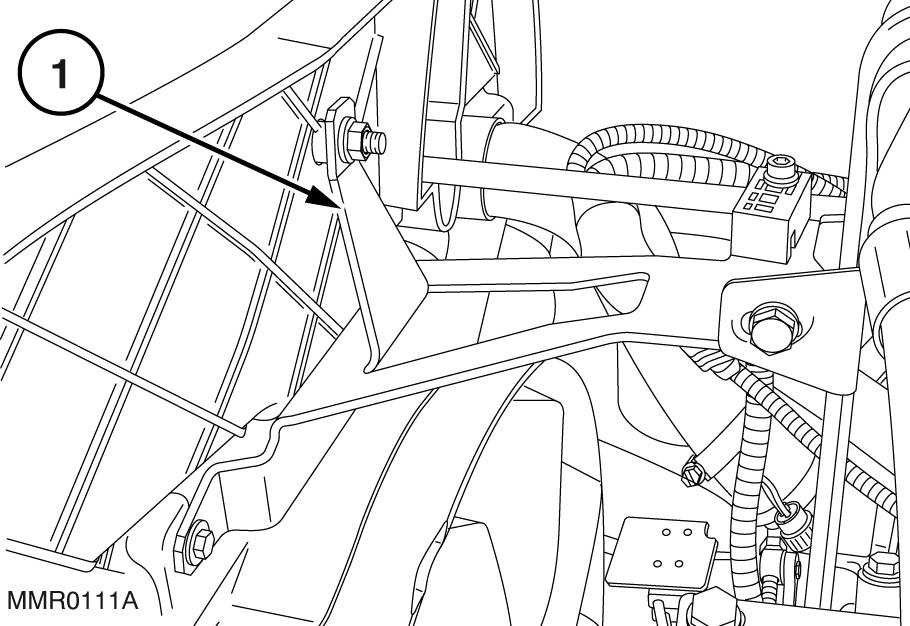
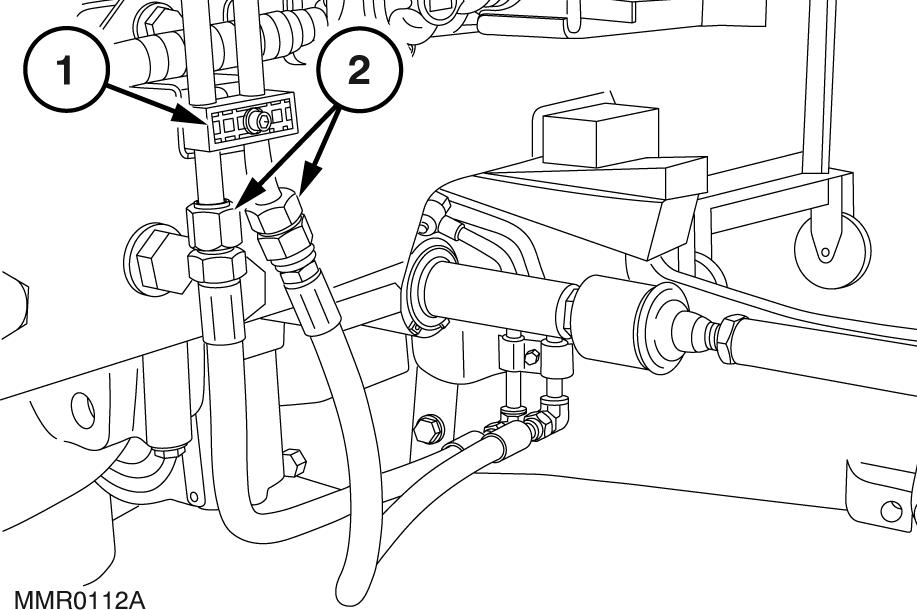
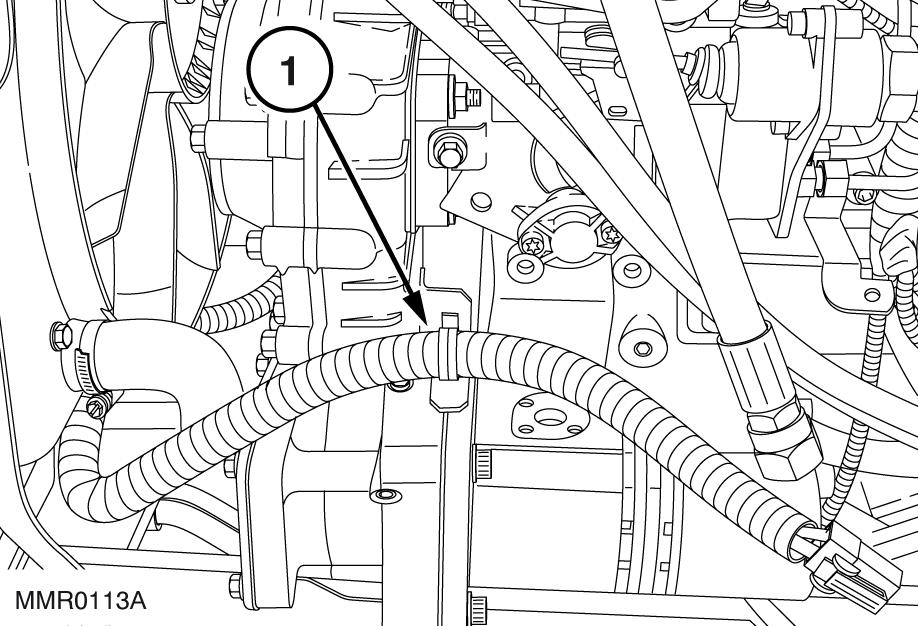
29. Disconnect the pipes (1 and 2) from the cab air conditioning system compressor.
30. Set afixed standunder thefront ofthe front axle support and one under the back of it.
31. Connect the engine to a chain (1) and to the hoist.
32. Unscrewthebolts(1),onbothsides,andremove the engine.
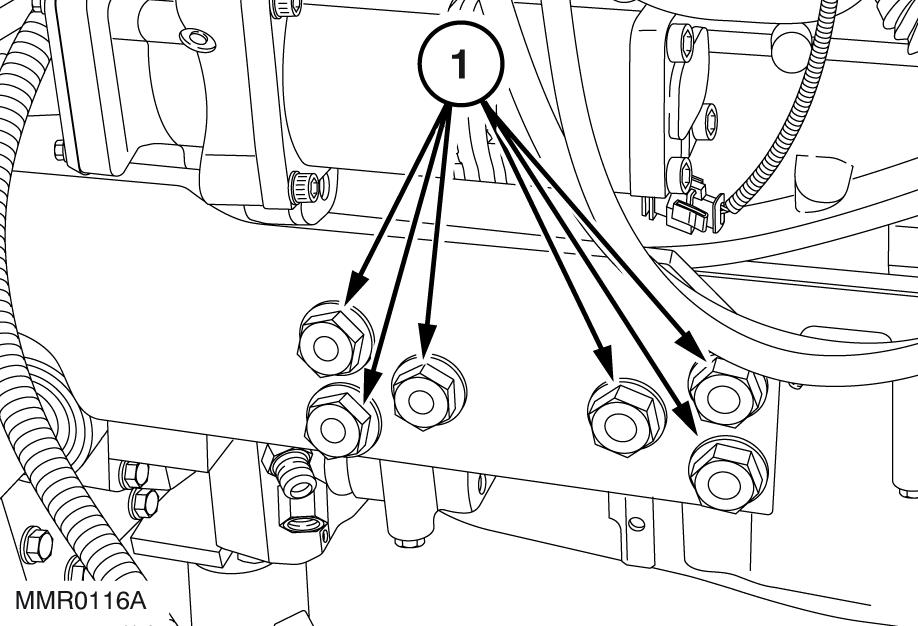
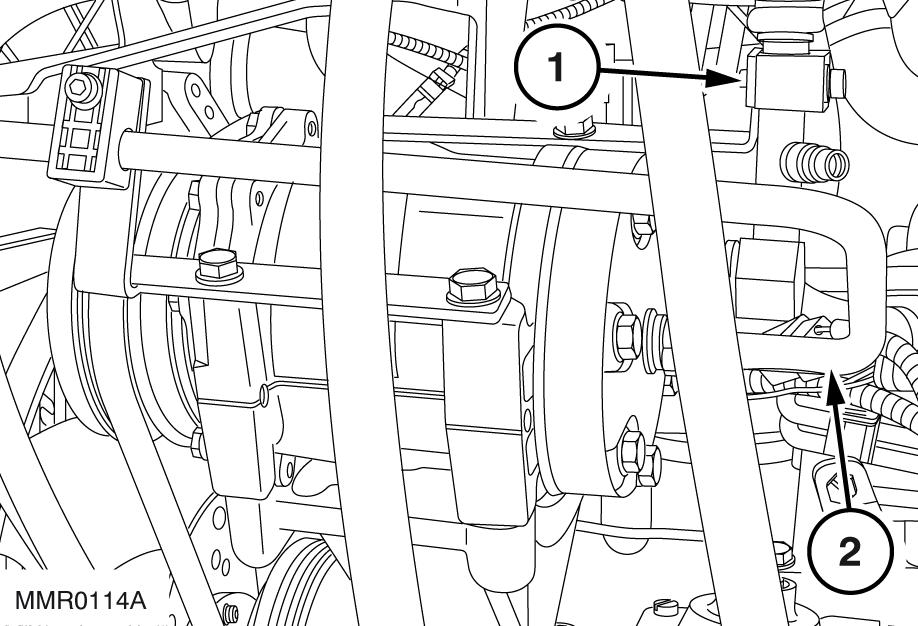
33. Then rest the engine on an adequate support.
34. Tore-fit the engine, proceed as follows:
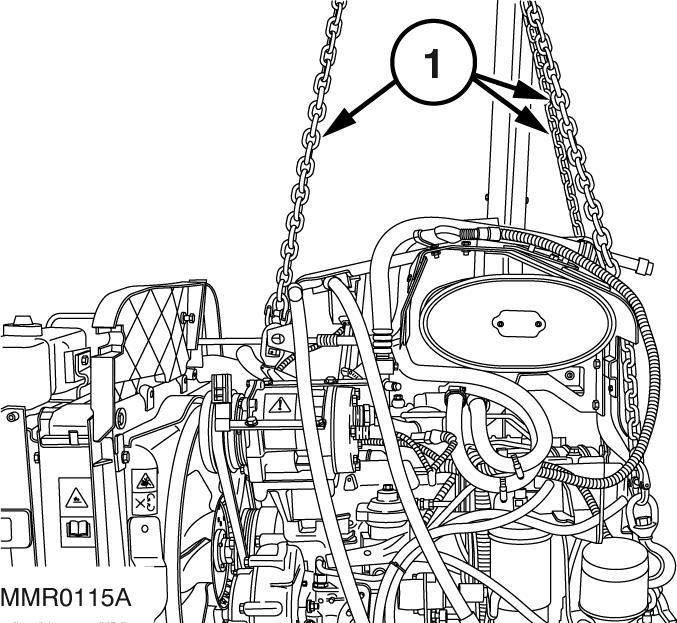
Use suitable tools to align the holes. NEVER USE FINGERS OR HANDS.
- Using a chain connect the engine to the hoist and reattach it to the front axle support tightening the screws to the prescribed torque.
- Connect the pipes to the compressor of the cab air conditioning system.
- Using the appropriate bracket, secure the maxi -fuse connecting cable.
- Secure the steering cylinder control lines using the relevant bracket.
- Connect the steering cylinder control piping.
- Position and secure the bracket retaining the radiator to the engine.
- Connect the electrical connection to the filter/dryer.
- Position and secure the maxi-fuse support bracket.
- Position and secure the sleeve connecting the turbocharger to the air filter.
- Position and secure the radiator upper sleeve.
- Position and connect the transmission oil cooler connecting pipes.
- Position the engine together with the front axle and secure it to the clutch box tightening the screws to the prescribed torque.
- Position the oil filter, complete with support, and secure it to the engine.
- Connect the pipes for the: hydraulic pump inlet, central auxiliary control valves connection and hydraulic pump connection.
- Position the propeller shaft, secure the central support, slide the two front and rear sleeves and secure them with the circlips.
- Position the propeller shaft guard and secure it.
- Position the pipe drawing oil from the transmission and secure it.
- Connect the rear transmission lubrication line.
- Connect the PTO control line.
- Connect the four-wheel drive engagement control line.
- Connect the rear auxiliary control valve connection line.
- Connect the central auxiliary control valve connection line.
- Connect the pipes connecting the power shuttle control valve to the cooler.
- Position and secure the right and left supports of the cab.
- Connect the central auxiliary control valve connection line to the rear auxiliary control valves.
- Connect the central auxiliary control valve return line to the rear transmission.
- Position and secure the ballast support.
- Position and secure the ballast.
- Carry out operation 90 150 10 - Cab with platform unit (perform installation only).
- Screw the plug into the rear transmission box and fill with oil (see sect. 00, page 6 for prescribed product and quantity).
Handle all parts with care. Do not put your hands or fingers between parts. Wear the prescribed safety clothing, including goggles, gloves and safety footwear.
Proceed as follows.
1. Block the front axle with wooden chocks (1). Do this on both sides.
2. Raise the rear of the tractor, position a fixed stand under the rear transmission box, unscrew the relevant fixing screws and detach the left rear wheel (1).
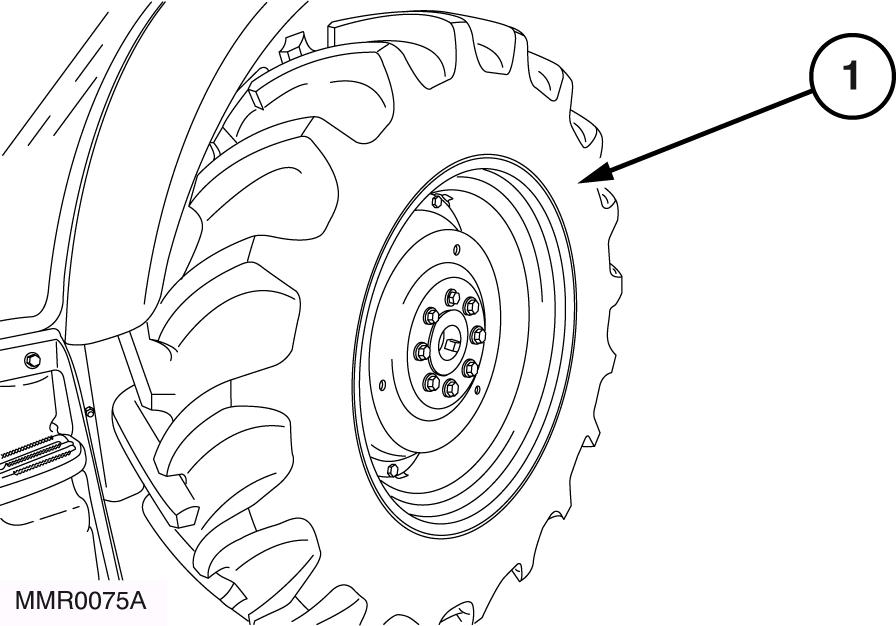
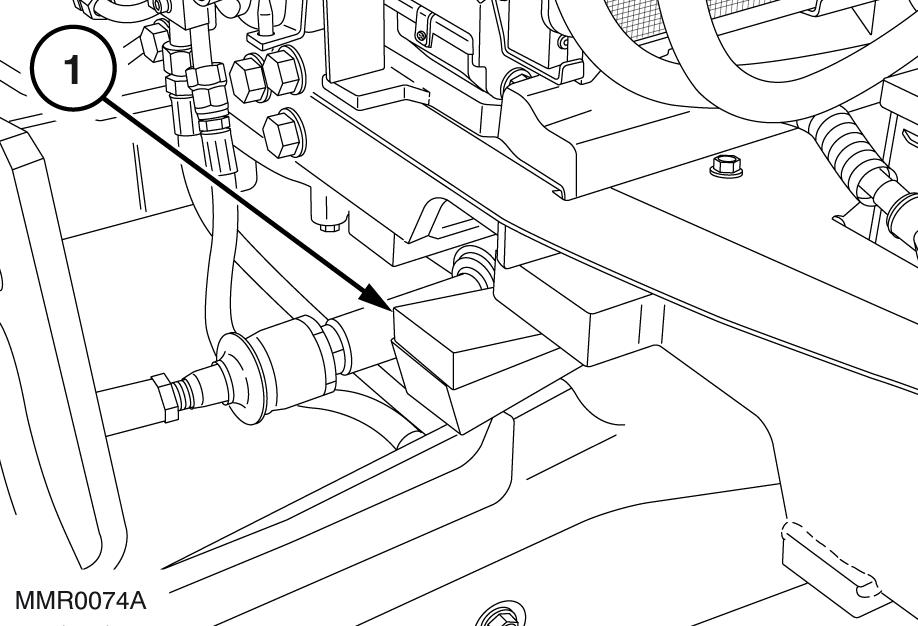
3. Unscrew the plug (1) and drain off the fuel from the main tank.
Consider that the total capacity is 90 litres.
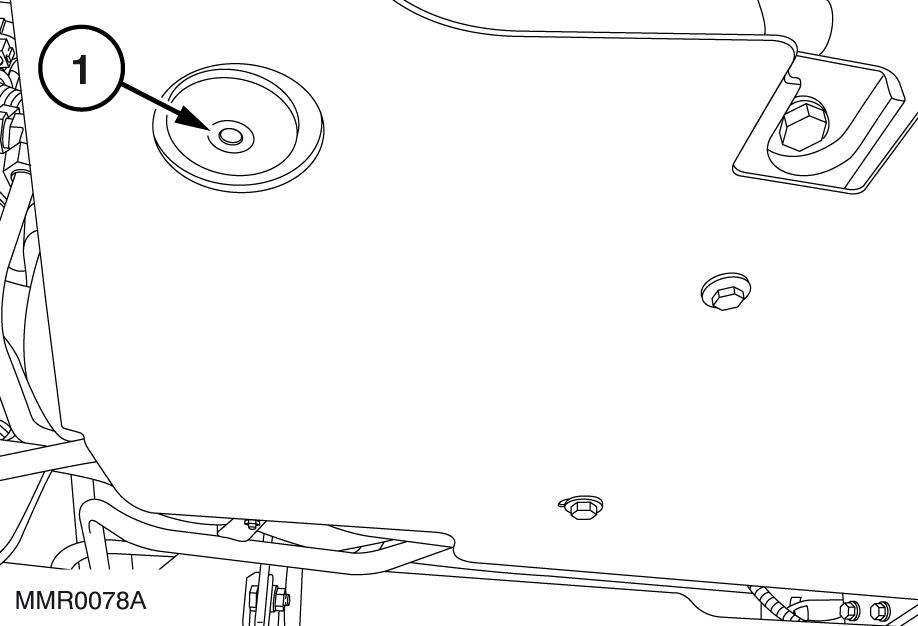
4. Unscrew therelevant retainingbolts andremove the left steps (1).
5. Unscrew the two fuel tank fixing clamps (3).
6. Unscrew the screws fixing the bottom guard (2) and detach it.
7. Unscrew the clamps (1 and 3) and detach the fuel return and inlet lines.

8. Disconnect the electrical connection (2) of the fuel gauge.
9. Unscrew the two brackets (1 and 2) fixing the fuel return and inlet pipes, finally remove the fuel tank.
10. To refit the fuel tank, proceed as follows.

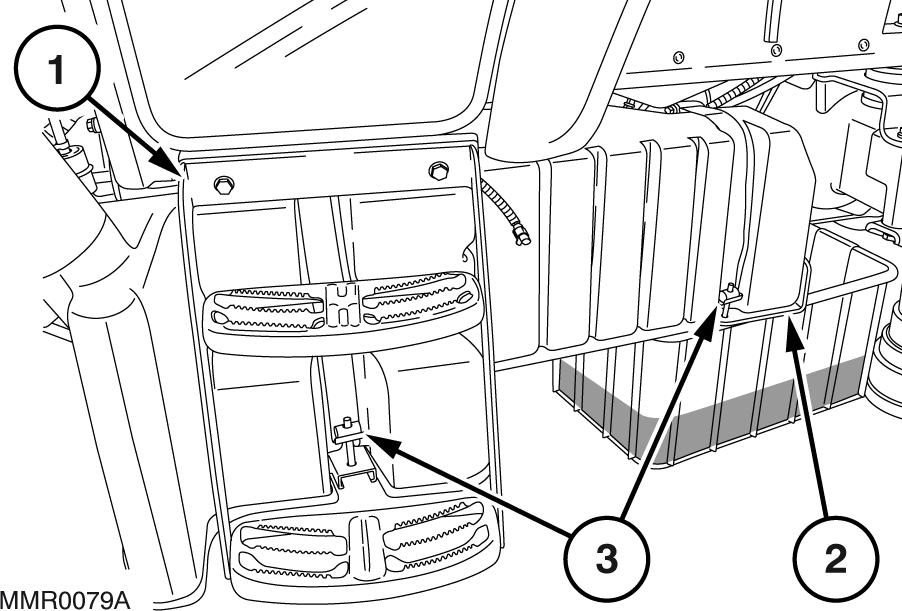
Use suitable tools to align the holes. NEVER USE FINGERS OR HANDS.
- Position and secure the tank fuel return and fuel inlet lines.
- Secure the tank fuel return and fuel inlet lines using the appropriate brackets. 28
- Connect the electrical connection of the fuel gauge.
- Position the fuel tank and secure it with the clamps
- Positionandsecure the bottomguard of thefuel tank.
- Position and secure the left steps.
- Position and secure the left rear wheel.
Removal-Installation
Handle all parts with care. Do not put your hands or fingers between parts. Wear the prescribed safety clothing, including goggles, gloves and safety footwear.
Proceed as follows.
1. Carryoutoperation 90100 22 - Bonnet(perform removal only).
2. Carryout operation 50 200 72 - Air-conditioning system condenser (perform removal only).
3. Carryoutoperation 21 109 40 - Transmissionoil cooler (perform removal only).
4. Loosentheclamp, detachthesleeve(1) fromthe radiator and drain off the coolant
5. Disconnect the air intake sleeve (1).
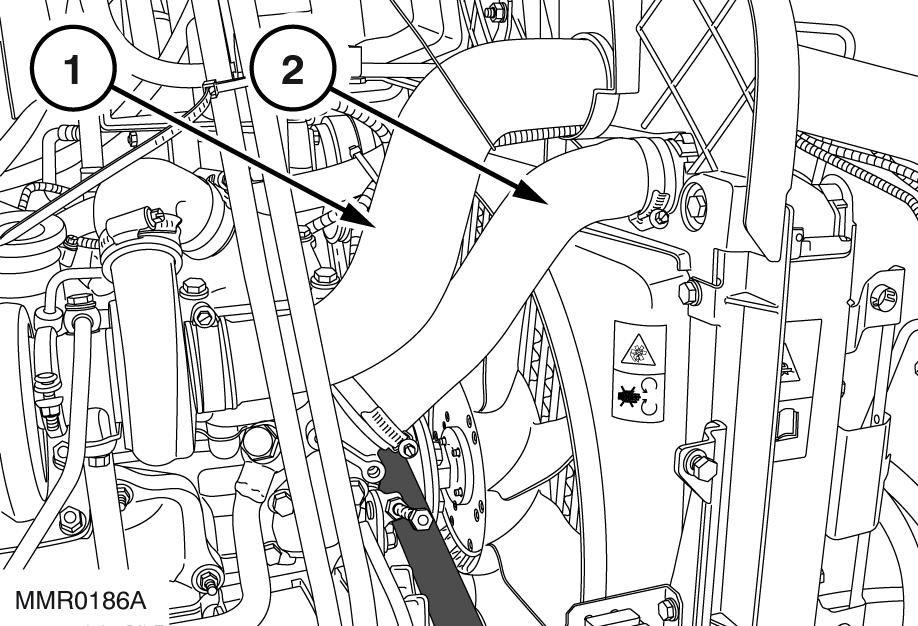
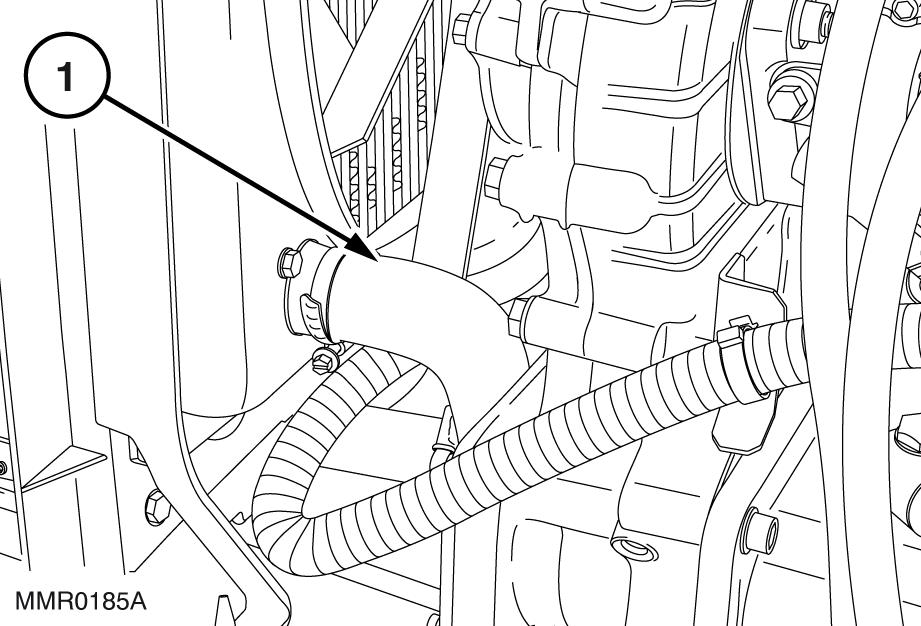
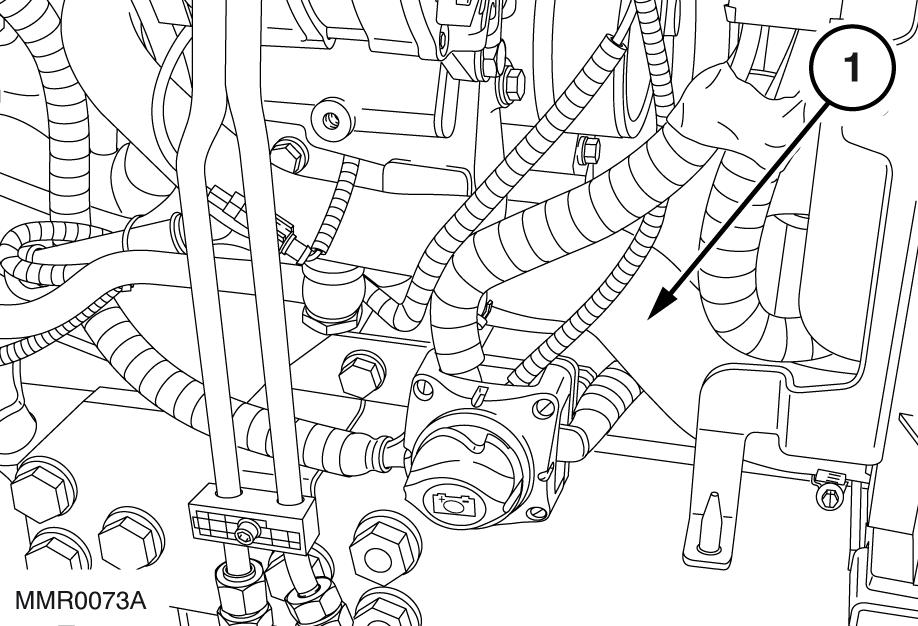
6. Disconnect the sleeve (1) from the air filter and from the turbocharger.
7. Disconnect the sleeve (2) from the radiator.

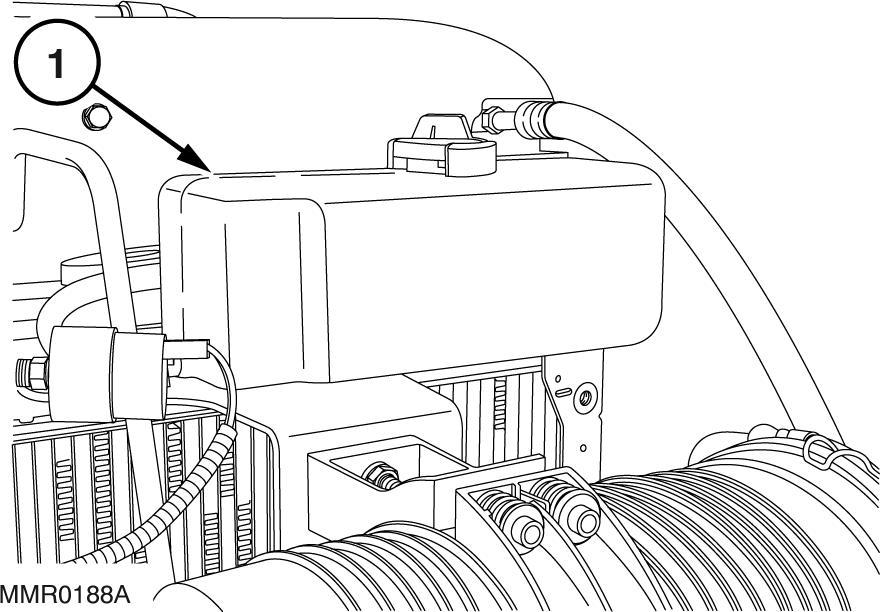
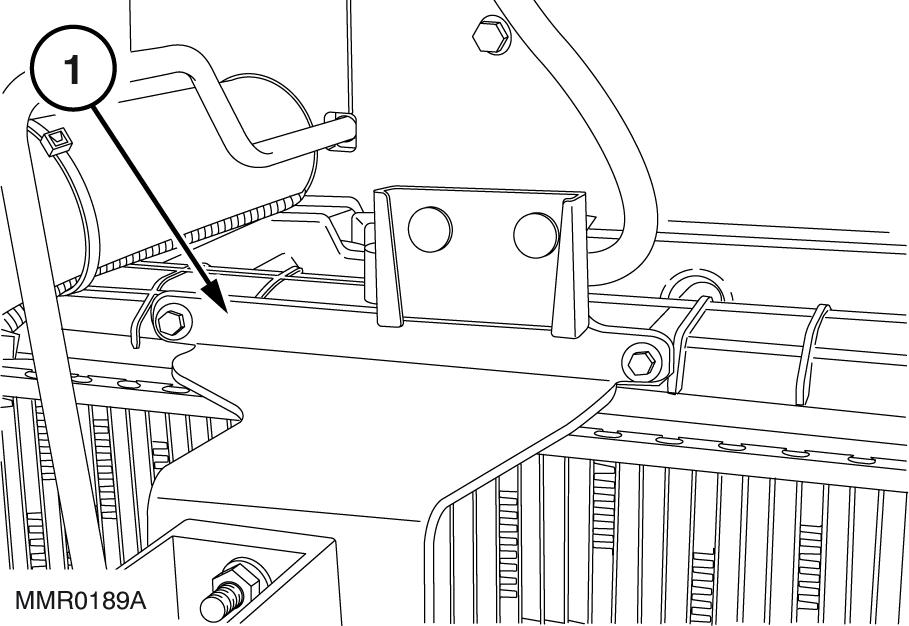
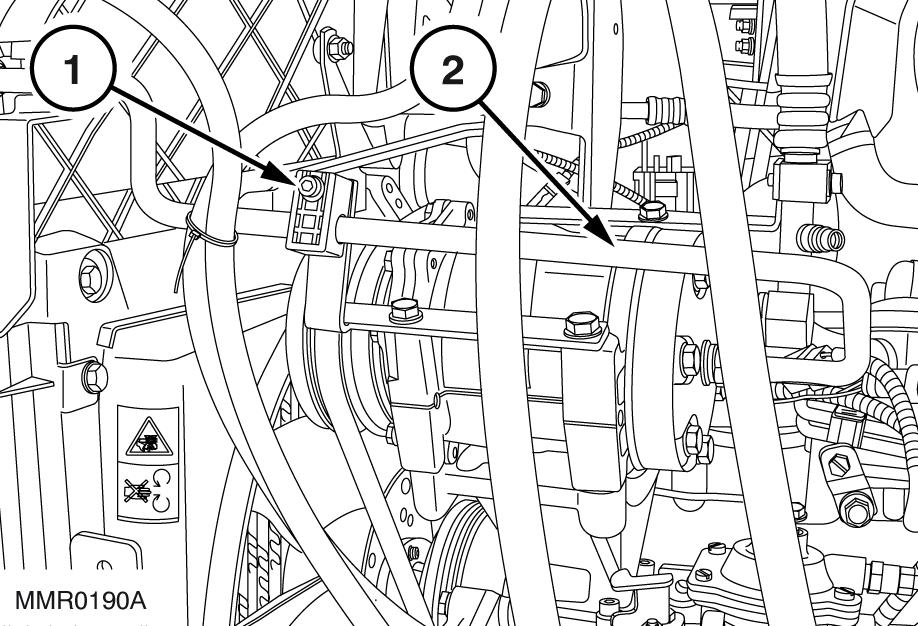
12. Unscrew the related bolts and remove the bracket (1) fixing the radiator to the engine.
13. On the right side, detach the brackets fixing the pipes of the air -conditioning system to the engine.
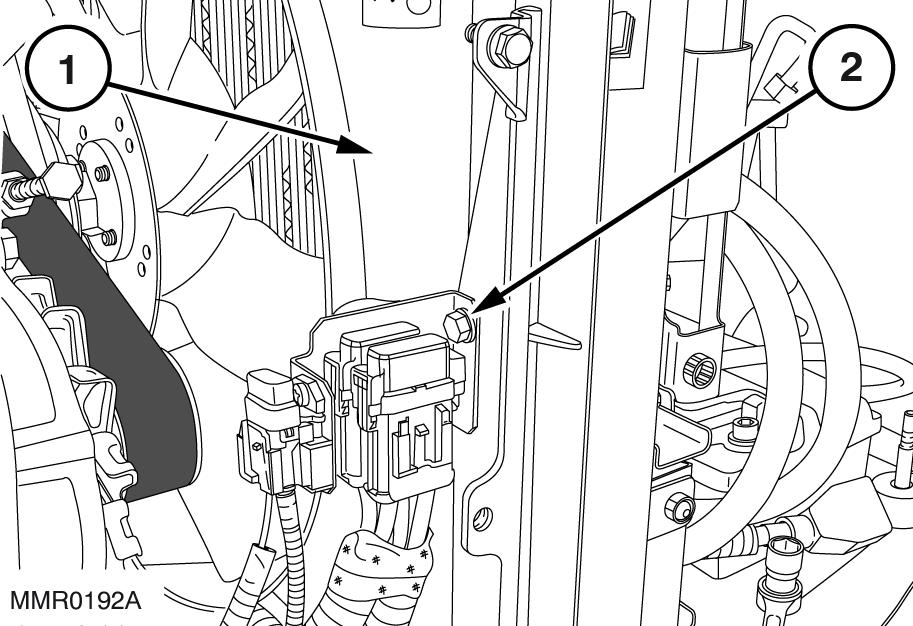

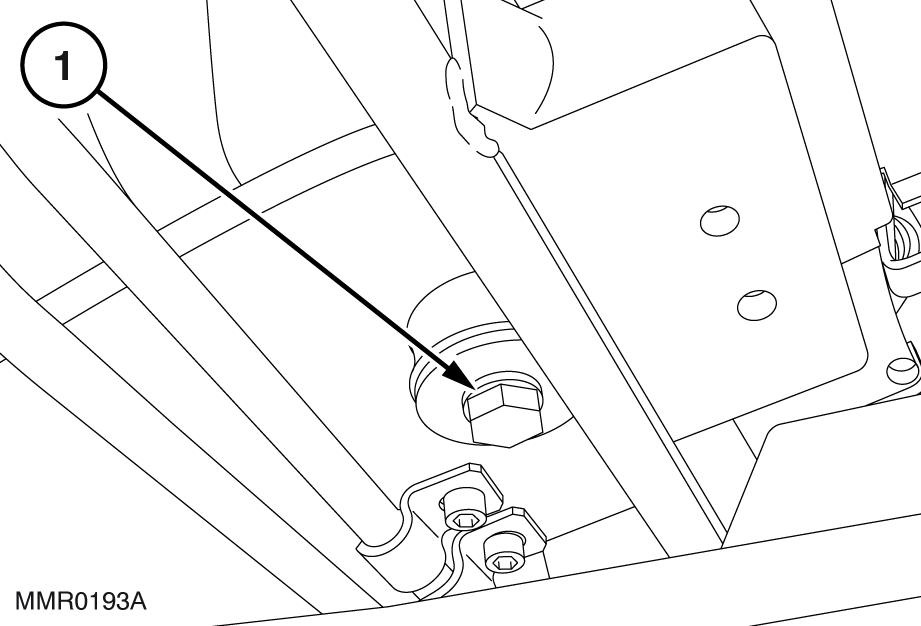
14. Detach the maxi-fuse support bracket (2) and unscrew the relevant screws to free the shroud (1) from the engine coolant radiator.
15. Unscrew the two bolts (1) and remove the engine coolant radiator.
16. Install the engine coolant radiator considering the following warnings.
Use suitable tools to align the holes. NEVER USE FINGERS OR HANDS.
- Position and secure the radiator on the front axle support.
- Secure: the shroud, maxi -fuse support bracket and the brackets fixing the air -conditioning pipes.
- Position and secure the radiator retaining bracket to the engine.
- Connect and secure the piping to the compressor.
- Position and secure the air filter unit and filter/dryer.
- Position the expansion tank.
- Connect:thepipesandthe electricalconnection to the filter/dryer.
- Connect the air filter sleeves.
- Connect the sleeves to the radiator.
- Connect the air intake sleeve.
- Carry out operation 21 109 40 Transmission oil cooler (perform installation only).
- Carry out operation 50 200 72 Air-conditioning system condenser (perform installation only).
- Carryoutoperation 90100 22 - Bonnet(perform installation only).
- Fill up the engine cooling system (see page 6, sect. 0 for prescribed product and quantity).
Use suitable tools to align the holes. NEVER USE FINGERS OR HANDS.
Proceed as follows.
1. Connect the throttle control cable (2) to the injection pump and tighten the nut (1) to eliminate the play in the cable.
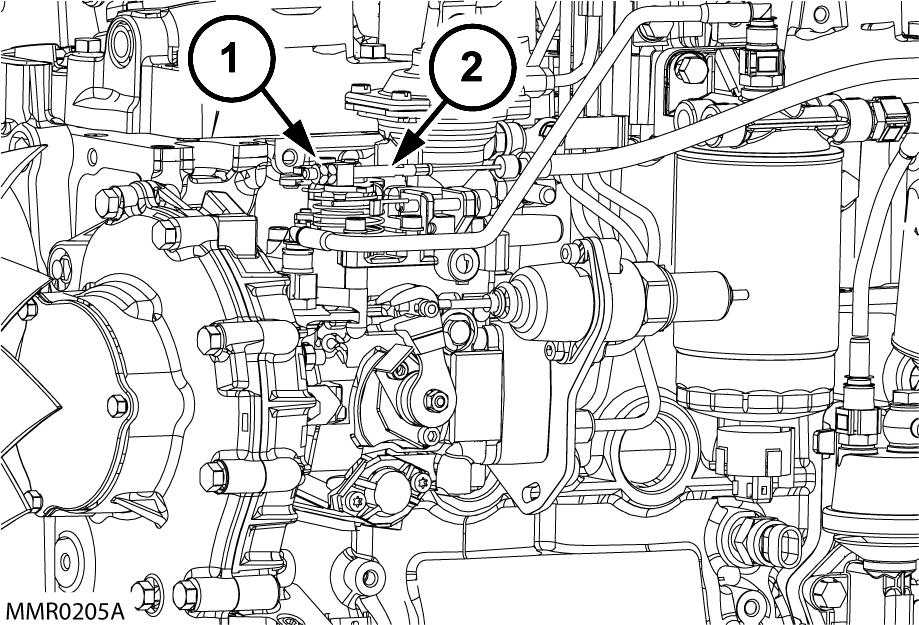
2. Fully tighten the throttle control pedal limit stop screw (1).
3. Apply aload (P) of10daN ± 1ontheaccelerator control pedal, tighten the limit stop screw (1) until contact is made with the platform and lock it by means of the relevant lock nut.
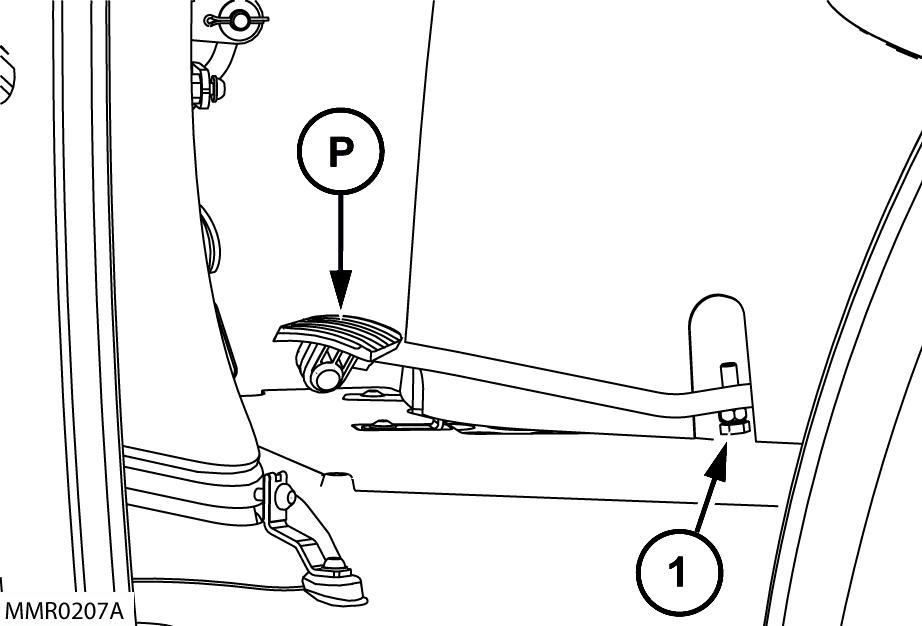

and release mechanism
single disk, dry plate dual clutch unit
control: pedal operation for main clutch and hand lever for power take -off clutch single Belleville spring disc
Driven plate lining material for main transmission clutch: ....... cerametallic
Driven plate lining material for PTO clutch organic
Driven disc
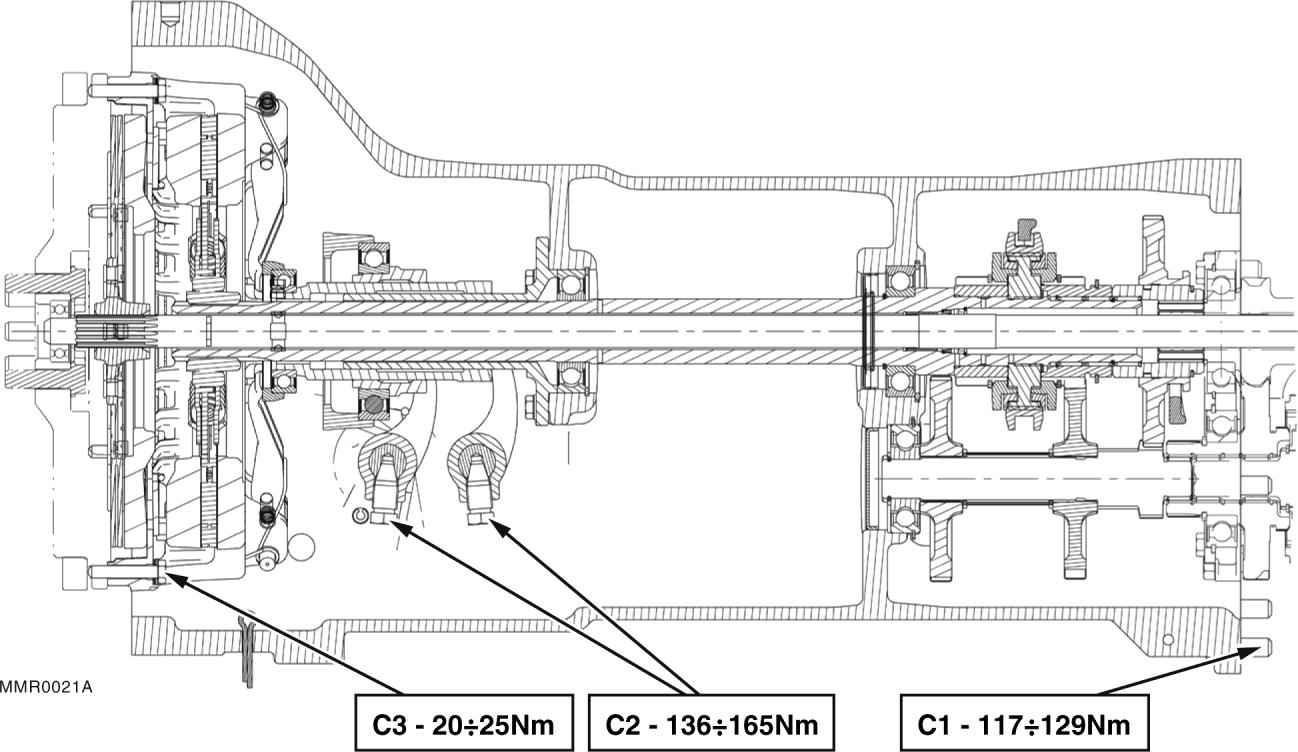
TOOLS
Warning - The operations described in this section can only be carried out with ESSENTIAL tools indicated by an (X).
To work safely and efficiently and obtain the best results, it is also necessary to use the recommended specific tools listed below and certain other tools, which are to be made according to the drawings included in this manual.
Longitudinal section of 11”/11” LUK clutch
1. PTO clutch release lever adjuster screw.
2. PTO clutch release levers.
3. Main clutch release levers.
4. Main clutch disk.
5. Main clutch release lever adjuster.
6. PTO clutch disk.
7. Belleville spring disk.
D = 100.5 mm Nominal distance of the levers (8) from the clutch/engine flywheel mating surface.
D1 = 140 mm. Nominal distance of the levers (4) from the clutch/engine flywheel mating surface.
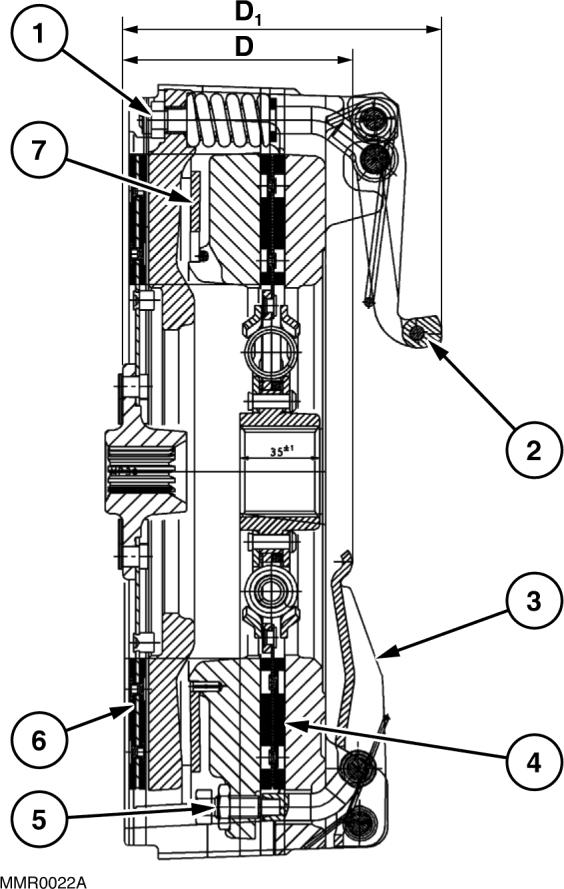
NOTE: During installation, apply sealing compound to surfaces X as shown in Section 21, Chapter 1, page 22.
List of specific tools required for the various operations described in this section.
X 380001612 Pinforcentering andadjustment of 11”/11” clutches.
X 380000293 Clutch adjustment gauge (with 380001612).
380000256 Set of wrenches for adjustment of levers in 11”/11” LUK clutches.
The clutch slips
Possible causes
1. Worn disks 4 and 6, page 3, on pressure plates and flywheel.
The clutch jerks
2. Belleville spring disk (7, page 3) stretched or damaged.
3. Oil or grease contaminating the friction lining of disks 4 and 6, page 3).
1. Partial seizure of the external control linkage.
2. Clutch disk (4, page 3) deformed.
3. Clutch disk (4, page 3) with torsion springs damaged or with hub rivets loose.
4. Oil or grease contaminating the disks friction material (4 and 6, page 3).
Check and compare the data given on the pages indicated, replace any parts which are worn up to or over the limit and adjust levers and clutch control linkage. Replace the Belleville spring.
Replace the disks, identify and eliminate the source of the lubricant inside the clutch housing and thoroughly clean the friction surfaces.
Check rod pivots and lubricate.
Replace the disk and adjust the clutch control lever.
Replace disk.
Replace the disks, identify and eliminate the source of the lubricant inside the clutch housing and thoroughly clean the friction surfaces.
Clutch sticks and drags
1. Clutch disks (4 and 6, page 3) deformed.
2. Seizure of external control linkage.
3. Controls incorrectly adjusted.
Replace and adjust disks.
Check, replace faulty parts andlubricate.
Adjust the controls (see page 12).
Clutch noisywhenengaged and/or disengaged.
1. Thrust bearing worn.
2. Clutch disk (4, page 3) with torsion springs faulty.
Replace bearing
Replace disk.
Clutch pedal too stiff
1. Partial seizure of the external control linkage.
2. Partial seizure of pedal pivot.
Check rod pivots and lubricate.
Check pivot and lubricate.
Lift and handle all heavy parts using suitable lifting equipment.
Make sure that assemblies or parts are supported by means of suitable slings and hooks. Ensure that no-one is in the vicinity of the load to be lifted.
Use suitable tools to align the holes. NEVER USE FINGERS OR HANDS.
Proceed as follows.
1. Carry out operation 10 001 10 Engine, only removal (see sect. 10).

2. Usingtool 380001612 (1),unscrewtheretaining bolts and remove the clutch (2).
3. To install the clutch on the engine flywheel, proceed as follows.
Use suitable tools to align the holes. NEVER USE FINGERS OR HANDS.
- Apply the torque settings listed on page 2.
- Before refitting the engine to the clutch box carefully clean the mating surfaces and apply sealing compound (approximately 2 mm diameter), according to the diagram shown in Section 21, Chapter 1, on page 22.
- Refit the clutch to the flywheel, using tool 380001612
- Carry out operation 10 001 10 Engine, only installation (see sect. 10).
Op. 18 110 30 11”/11” DUAL DISK CLUTCHTest bench overhaul


Use suitable tools to align the holes. NEVER USE FINGERS OR HANDS.

Proceed as follows.















13. Extract the pivot pins (1) on the main clutch control levers.
14. To refit the clutch, proceed as follows.

Use suitable tools to align the holes. NEVER USE FINGERS OR HANDS.
- Refit thelever pivotpins andtherelativesprings.
- Refit the main clutch disk in the clutch housing.
- Installthemainclutch pressureplate, securingto

the pins with the bolts.
- Install the Belleville spring disk, carefully position the three clamps and evenly and progressively compress the spring. Insert the six pins, making sure that they are securely inserted in their respective seats, then remove the clamps.
- Install the PTO clutch disk; fit the three washers and the coil springs on the pins and secure with the three nuts.
Handle all parts with care. Do not put your hands or fingers between parts. Wear the prescribed safety clothing, including goggles, gloves and safety footwear.
Minimum permissible dimensions after refacing of parts subject to wear in the 11”/11” dual clutch
A ≥ 15.5 mm; B ≥ 22.7 mm; D ≥ 15.8 mm.

1. Flywheel.
2. PTO clutch pressure plate.
3. Main clutch pressure plate.
4. Clutch cover.
Minimum permissible dimensions after refacing of parts subject to wear in the 11”/11” dual clutch.
- Check the friction surface conditions of the pressure plates and the clutch casing. Generally, by means of turning, up to 1 mm of material can be removed from the cast iron friction surfaces of the clutch cover (3), the pressure plate ring (2) and the flywheel (see engine repair manual).
When parts (1), (2), (3) and (4, fig. 17), are to be repaired by removing material, proceed as follows:
- If it is necessary to reface the friction surfaces on the PTO clutch pressure plate (2, fig. 17), remember that the amount removed in relation to the nominal thickness (A), must also be removed from the base of the flywheel housing (4, fig. 17) in order to regain the original position of the pressure plate (2) in relation to the flywheel.
The position indicated by (C) of the clutch cover (4, see fig. 17) must be calculated using the following formula:
C = 71.4 + A
Where:
A = Thickness of the pressure plate after refacing.
C = Height of the clutch cover after refacing.